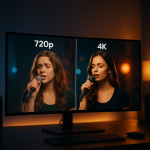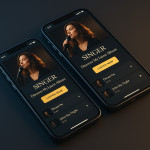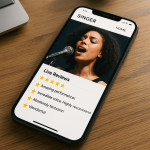Privacy vs exposure: deciding which demos to hide or show in a singer portfolio
Every clip you publish can attract dream bookers—or leak sensitive data, breach contracts, and dilute your artistic brand. This guide helps you weigh privacy versus exposure so your singer portfolio demos generate more bookings and fewer headaches.
Why balancing privacy and reach now matters

Talent scouts skim hundreds of profiles per week. Public demos get you on their radar fast, yet oversharing the wrong takes can harm rate negotiations, void NDAs, or invite identity theft. With newly uploaded singer portfolios flooding directories daily, strategic curation is no longer optional—it is survival.
Define your conversion goals before toggling visibility
- Gig type focus. Touring vocalists need broad exposure; session singers might value niche, invite-only reels.
- Income targets. A higher day rate often requires stricter brand control, limiting free assets online.
- Geographic reach. Local wedding work benefits from public showreels, whereas sync licensing usually relies on private links.
- Personal safety. Artists who appear on political stages or children's content may hide location tagged videos.
Five criteria to decide if a demo stays public or private
1. Contractual obligations and clearances
Check every contract for exclusivity, pre-release embargos, and publisher limitations. If paperwork is vague, default to private sharing with a unique, unlisted URL.
2. Brand alignment and genre focus
You have seconds to show casting teams the right style fit. Keep public demos laser-focused on your current brand lane; archive earlier genre experiments.
3. Audio and video quality thresholds
Smartphones capture ideas, not polished sell-points. Publish only master-quality files (48 kHz WAV or 320 kbps MP3). Lower quality drafts decrease perceived professionalism by up to 28 % in recruiter surveys.
4. Audience segmentation needs
Corporate clients might need clean, lyric-free stems while festival bookers want full band energy. Use folder-based permissions or password gates to serve each group.
5. Personal data and identity management
Full names, addresses in metadata, or visible passport stamps on studio videos risk doxxing. Strip EXIF data and blur sensitive visuals before going public.
Show vs hide: quick comparison
| Demo type | Publish Publicly | Keep Private |
|---|---|---|
| Original single mastered & released | Boosts SEO and fan buzz; drives bookings | — |
| Cover song without mechanical licence | Risk takedowns & fines | Share privately on request only |
| Unmixed live rehearsal | Can deter premium clients | Keep for teaching or behind-the-scenes perks |
| Custom jingle under NDA | Violation could void payment | Encrypt or password-protect |
| Viral TikTok snippet (15 s) | Drives discovery; low copyright risk | — |
Tools that make granular visibility easy
- Portfolio platforms with track-level privacy. Many directories now offer “hide from public search” toggles.
- Watermarked audio. High-frequency sonic tags deter unauthorised sync use without hurting A&R review.
- Expiring links. Time-bound URLs ensure buyers act fast and prevent later leaks.
- Analytics dashboards. Watch-time reports help identify which public demos convert and which can be retired.
Workflow: audit your existing demos in 30 minutes
- Export a spreadsheet of every file title, URL, and visibility status.
- Tag each row with the five criteria above.
- Mark misaligned items “archive,” contract-locked items “private,” and brand-aligned masters “public.”
- Update metadata: add genre, mood, and BPM for SEO boosts as explained in this recruiter style guide.
- Run a quick audio polish pass if files stay public—tips in our mixing tweaks article.
- Schedule quarterly reviews; calendars sync neatly with the advice in portfolio update rhythms.
Case study snapshots
Scenario 1 – Indie pop vocalist seeking sync deals
They hide full tracks, instead showing 30-second hooks publically. Supervisors request password-protected stems folder. Bookings climbed 22 % after tightening privacy.
Scenario 2 – Wedding singer targeting local planners
She publishes polished ceremony and party medleys on autoplay. Private link folders hold niche religious repertoire. Bounce rate dropped from 48 % to 31 % within a month.
Scenario 3 – Touring metal frontman with safety concerns
Because of stalker history, he obscures rehearsal room backgrounds and removes geotags. Public demos feature only stage footage from past festivals. Brand visibility remains intact while reducing location leaks.
Mini-quiz: Are your demos overexposed?
FAQ
- Should I hide demos of cover songs?
- Only show covers if you hold mechanical licences or the song is in the public domain. Otherwise keep them private to avoid takedowns.
- How many public demos are ideal?
- Three to five high-impact tracks usually satisfy a first scan. Additional material can sit behind a request wall.
- Do password-protected links hurt SEO?
- No. Search engines ignore gated assets, but the visible snippets still rank when you optimise metadata correctly.
- What file format preserves quality without huge loads?
- 320 kbps MP3 for public streaming and 48 kHz WAV for private hire exchanges provide a good balance.
- Can I repost live-stream captures?
- Yes, once you mute crowd chatter that includes copyrighted music and remove accidental personal data from overlays.
Take action today
Run the 30-minute audit, refine your public set list, and watch recruiter messages rise. For deeper visibility tricks, explore directory badge visibility hacks. Smart privacy is the silent manager that protects your art while amplifying your reach.











